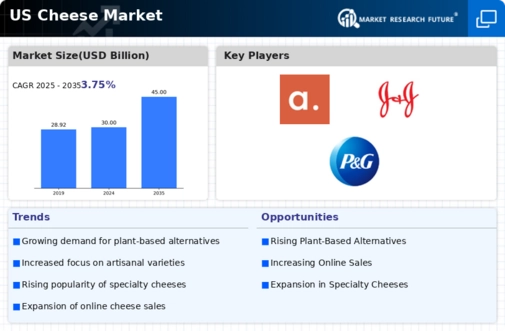The cheese market exhibits a dynamic competitive landscape characterized by a blend of innovation, strategic partnerships, and regional expansion. Key players such as Lactalis (FR), Dairy Farmers of America (US), and Kraft Heinz (US) are actively shaping the market through diverse operational focuses. Lactalis (FR) emphasizes product innovation, particularly in specialty cheeses, while Dairy Farmers of America (US) leverages its cooperative structure to enhance supply chain efficiencies. Kraft Heinz (US) is increasingly investing in digital transformation to optimize its marketing strategies and consumer engagement. Collectively, these strategies contribute to a moderately fragmented market, where competition is driven by both product differentiation and operational excellence.
In terms of business tactics, companies are increasingly localizing manufacturing to reduce transportation costs and enhance freshness. Supply chain optimization remains a critical focus, particularly in light of fluctuating raw material prices. The competitive structure of the cheese market is moderately fragmented, with several key players exerting influence over pricing and product availability. This fragmentation allows for niche players to thrive, while larger companies seek to consolidate their market positions through strategic acquisitions and partnerships.
In October 2025, Lactalis (FR) announced the acquisition of a regional cheese producer in the Midwest, aiming to expand its footprint in the US market. This strategic move is likely to enhance Lactalis's distribution capabilities and diversify its product offerings, thereby strengthening its competitive position. The acquisition aligns with the company's broader strategy of increasing market share through targeted investments in local production facilities.
In September 2025, Dairy Farmers of America (US) launched a new line of organic cheeses, responding to the growing consumer demand for sustainable and health-conscious products. This initiative not only caters to evolving consumer preferences but also positions the company as a leader in the organic segment of the cheese market. By focusing on sustainability, Dairy Farmers of America (US) is likely to attract a more health-conscious demographic, thereby enhancing its market appeal.
In August 2025, Kraft Heinz (US) unveiled a digital marketing campaign aimed at promoting its cheese products through social media platforms. This campaign leverages data analytics to target specific consumer segments, enhancing engagement and driving sales. The emphasis on digital marketing reflects a broader trend within the industry, where companies are increasingly utilizing technology to connect with consumers and differentiate their products in a crowded marketplace.
As of November 2025, current competitive trends in the cheese market are heavily influenced by digitalization, sustainability, and the integration of artificial intelligence in production processes. Strategic alliances are becoming more prevalent, as companies seek to enhance their capabilities and market reach. Looking ahead, competitive differentiation is expected to evolve, with a notable shift from price-based competition towards innovation, technology adoption, and supply chain reliability. This transition underscores the importance of agility and responsiveness in meeting consumer demands in an ever-changing market.














Leave a Comment